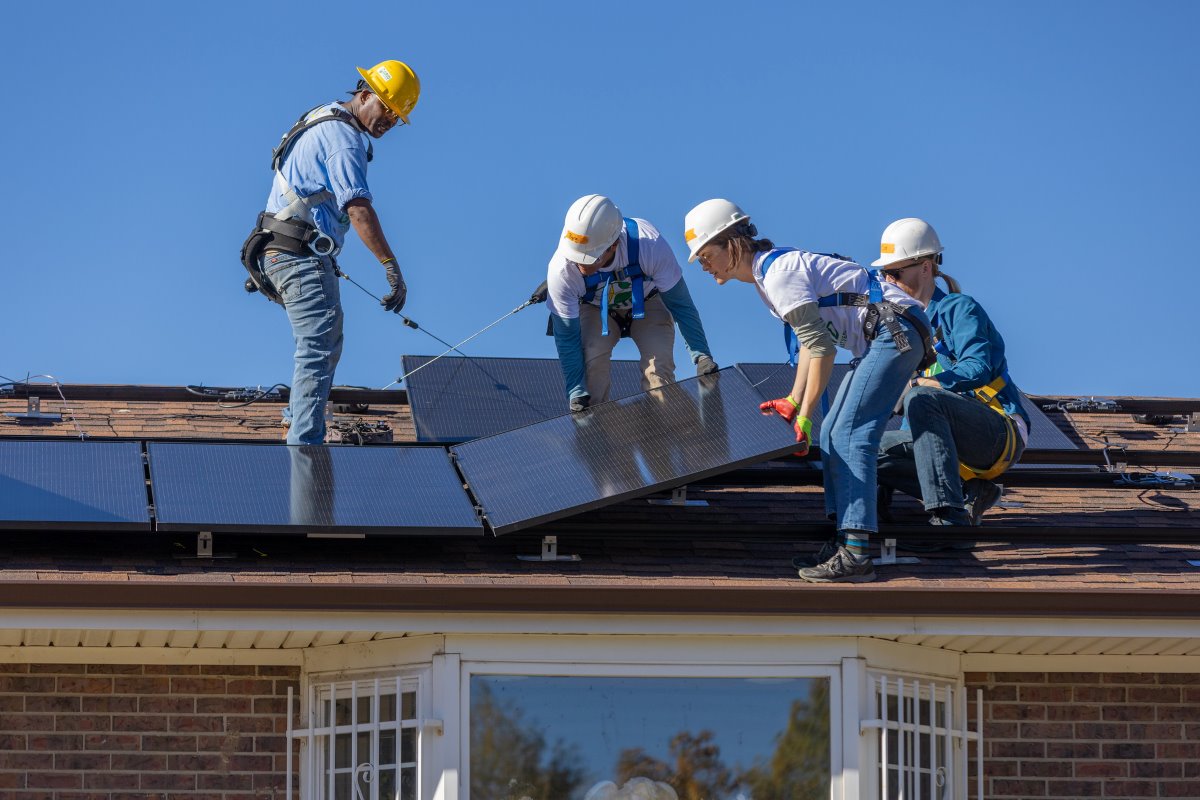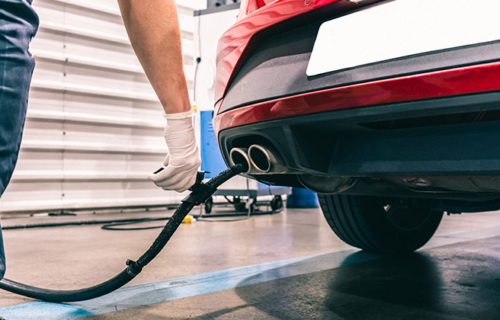Good Climate News this Week: National Monument Expansions, Lead Pipe Removal, Clean Energy Permitting, and More!
May 3, 2024
 Staff from the National Renewable Energy Laboratory and GRID Alternatives Colorado install rooftop solar panels during a volunteer event with GRID Alternatives Colorado. The 6.7kW solar installation project should provide the home with $1,200 annual savings over the next 20 years. Credit: U.S. Department of Energy
Staff from the National Renewable Energy Laboratory and GRID Alternatives Colorado install rooftop solar panels during a volunteer event with GRID Alternatives Colorado. The 6.7kW solar installation project should provide the home with $1,200 annual savings over the next 20 years. Credit: U.S. Department of Energy
Using fewer fossil fuels and more clean energy to power your home or vehicle will not only help save the climate, but help you save money as well. Home updates to improve energy efficiency will decrease heating and cooling costs. Switching from a gas, propane, or fuel oil furnace to a heat pump can save even more. And clean vehicles are less expensive to power and maintain than gas-powered ones.
Tax incentives to help make these changes are available thanks to the Biden-Harris administration’s affordable clean energy plan. Together with environmental champions in Congress, the Biden-Harris administration passed historic investments in clean energy and the climate with the Bipartisan Infrastructure Act of 2021 and the Inflation Reduction Act in 2022. This legislation established programs to jumpstart the clean energy transition and curb pollution at all levels, from infrastructure and industry to our homes and vehicles.
To help people make cleaner and more energy efficient updates and lower their costs at home, the Inflation Reduction Act established clean energy tax incentives including:
Many of these incentives were first available in 2023, with more launching in 2024 and beyond. If you’re a homeowner, a renter, or planning to buy an electric vehicle, learn how you may be able to save.
Federal tax credits can provide homeowners up to $3,200 annually to lower the cost of energy efficient home upgrades by up to 30 percent. Learn more about the range of qualifying improvements, their money and planet-saving benefits, and even more ways to save.
A home energy audit can uncover ways to make your home more energy efficient and lower your utility bills.
Save money: Tax credit for audit costs up to $150. Making energy efficiency upgrades identified in the audit can save you 5-30% on your energy bill.
Save the planet: An audit identifies how you can improve your home to use less energy, and reduce or replace use of fossil-fuel burning appliances.
Sealing leaks and upgrading doors and windows that allow too much air to escape will reduce the energy needed to keep your home at a comfortable temperature.
Save money:
Save the planet: Lowering its energy consumption to maintain a comfortable temperature will reduce your home’s carbon footprint.
Replacing old or failing appliances with energy-efficient models reduces energy use and, when replacing gas-powered appliances, makes your indoor air healthier.
Save money: Rebates of up to $840 for Energy-Star Certified appliances will be available through state programs funded by the DOE. Most programs are expected to launch in 2024 or 2025 and you can visit Energy.gov’s tracker to keep tabs on your state’s status.
Save the planet (and your health): Energy-Star Certified appliances use less electricity than older electric or gas appliances. A certified electric stove is about three times more energy efficient than a gas stove, and an induction stove is even more efficient. Replacing gas appliances such as stoves also improves indoor air quality. Studies show that gas stoves emit nitrogen dioxide and other air pollutants that pose respiratory health risks, especially for children and people with lung diseases like asthma. Gas stoves also leak heat-trapping methane gas into the environment.
Upgrading your heating and cooling with more energy efficient options often has the most impact of all home improvements on your utility bills and on the climate. Replacing a fossil-fuel-burning gas, propone, or fuel oil furnace with an electric heat pump reduces pollution and long-term energy costs. Heat pumps are three to five times more efficient than furnaces and, despite their name, heat pumps don’t just heat – they also cool. You can replace both your furnace and existing air conditioner with a single, more efficient, heat pump. Learn more about different types of heat pumps including ductless mini-split, air source, and geothermal (see more about additional benefits for geothermal below).
Save money:
Save the planet: Replacing fossil-fuel burning furnaces with heat pumps vastly reduces a household’s carbon emissions. If all single family homes in the U.S. adopted heat pumps, the total annual emissions reduction would be equivalent to taking at least 32 million cars off the road, according to an analysis by Rewiring.
Sign up for a community solar plan to save on your electricity bill. You may be able to take advantage of solar energy with no cost to you. In a community solar program, a solar farm feeds power to the local electric grid. Solar subscribers get power from their local utility as normal, but the utility credits them for the amount of solar electricity generated for their share. Learn more and look for a program in your area with Rewiring’s guide to community solar.
Talk to your landlord about home electrification. While renters have fewer opportunities to take advantage of energy efficiency incentives, they can encourage their landlords to do so. Rewiring’s guide to talking to your landlord about electrification includes an email template to tell your landlord how electrification could reduce their operating costs while helping the planet.
Look into assistance programs for low-income households. The Weatherization Assistance Program through the U.S. Department of Energy and the Low Income Home Energy Assistance Program by the Department of Health and Human Services both help qualifying households with energy costs and improvements.
You can save 30% of the cost of new, qualified clean energy systems installed on your property including solar and wind energy, solar water heaters, geothermal heat pumps, fuel cells and battery storage.
If the conditions at your home are right, installing solar panels or a small wind electric system can give you significant energy savings in the long run and greatly reduce your carbon footprint.
Save money:
Save the planet: Electric power generation is the second largest contributor to U.S. greenhouse gas emissions, right behind transportation, and residential energy use accounts for 20% of total emissions. Wind and solar power are the cleanest energy sources available, with wind power producing an emissions footprint of four grams of carbon dioxide equivalent per kWh produced and solar power producing six grams, compared to 78 grams for gas and 109 grams for coal.
Geothermal heat pumps take advantage of the constant temperature underground to efficiently heat and cool homes with less electricity. A buried loop pulls heat from the ground to supply warmth, or pulls heat from the home into the ground to cool it.
Save money:
Save the planet: Geothermal heat pumps produce 85-90% fewer emissions than fossil fuel appliances. Their lower electricity usage – for example, a study by RMI found that they use four times less electricity than air source pumps on the coldest days – also reduces reliance on the electricity grid.
Solar water heaters use various collection and circulation methods to heat water with the sun’s thermal energy.
Save money:
Save the planet: A solar water heater can cut household emissions in half, saving 2 tons of carbon dioxide from entering the atmosphere annually – the equivalent of not driving your car for four months each year.
Battery storage saves energy from solar or wind power for later use, reducing or eliminating the need to rely on backup utility power at night or in unfavorable weather conditions. Fuel cells generate electricity and heat by converting hydrogen and oxygen into water through an electrochemical process.
Save money:
Save the planet: Using fuel cells or adding battery storage to a residential clean energy system reduces demand for utility-supplied electricity, and can eliminate the need for backup diesel generators during utility outages.
Use the Savings Calculator and Personal Electrification Planner from our partner Rewiring America to get personalized information on clean energy incentives you may qualify for and how different upgrades could lower your bills.
Visit the Energy Savings Hub from the Department of Energy to find a detailed list of tax incentives available for home upgrades, including appliances and energy efficiency improvements, and how to claim them when filing.
Use Energy Star’s Rebate Finder to find rebates and incentives available from your local utility companies in addition to tax incentives, and get more information on how the federal tax credits work.
See also:
Tax credits or point-of-sale rebates are available on the purchase of eligible models of new or pre-owned all-electric, plug-in hybrid, or fuel cell electric vehicles. Benefits are subject to income limits.
Save money:
Save the planet:
See guides from fueleconomy.gov and Consumer Reports to learn more about the tax credits and which vehicles qualify.
Curious whether a clean vehicle is right for you? Explore the Environmental Protection Agency’s guide to green vehicles including common EV myths.
In addition to taking advantage of these incentives yourself to reduce your bills and your carbon footprint, share this information with family and friends so they can do the same. Share this blog post and our Instagram slideshow to help spread the word!
The information on this page is not intended as legal or tax advice for specific individuals or organizations or actual determination of eligibility for tax credits and/or deductions of any particular project or activity. Please visit the IRS website for more information on tax credits and deductions under the Inflation Reduction Act of 2022, and you may choose to consult with a tax advisor.
Act Now
Tailpipe emissions are the leading cause of climate change in the U.S., and lead to respiratory diseases like asthma. The Biden-Harris administration just finalized stronger rules that protect us from tailpipe emissions while accelerating clean vehicle adoption. Take action to thank President Biden and EPA Administrator Regan for helping to protect the health of families, reduce carbon pollution, and bring us close to 100% new clean vehicles sold by 2035.
Send a Message Now